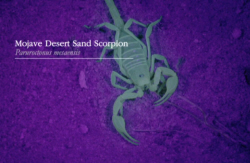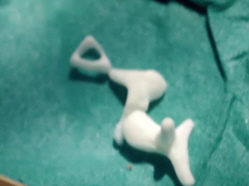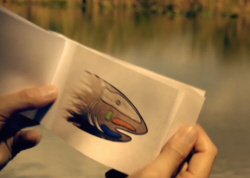Mojave Desert Sand Scorpion
Mammalian Hearing
What is Life?

Mojave Desert Sand Scorpion
I'm in the Mojave Desert in California, to track down an animal that can tell us something about the origins of our own senses. The creature I'm
looking for is easiest to find in the dark, using ultra-violet light.
Man! Did you see that? Look at that. Absolutely bizarre. It's glowing absolutely bright green. Nobody has any idea what evolutionary advantage that confers.
Although they now live in some of the driest, most hostile environments on Earth, like here in the desert, scorpions evolved as aquatic predators before
emerging onto the land about 380 million years ago.
They've adapted to be able to survive the extreme heat, and can go for over a year without food or water. Despite their fearsome reputation, 98% of
scorpion species have a sting that is no worse than a bee's.
Perhaps the most fascinating thing about scorpions from an evolutionary perspective is the way that they catch their prey.
You see that he spreads
his legs out on the surface of the sand. And that's because he uses his legs to detect vibrations.

Scorpion detects Vibrations
Scorpions hunt insects like this beetle. It's almost impossible to see them in the dark, so the scorpion has evolved another way to track
them down, by adapting its sense of touch. As the insect's feet move across the sand they set off tiny waves of vibration through the ground.
If just a single grain of sand is disturbed within range of the scorpion, it will sense it through the tips of its legs. They can detect vibrations
that are around the size of a single atom as they sweep past.
By measuring the time delay, between the waves arriving at each of its feet, the scorpion can calculate the precise direction and distance to its prey.
And that ability to detect vibrations and use them to build up a picture of our surroundings is something that we share with scorpions. While
the scorpion has adapted its sense of touch to detect vibrations in the ground, we use a very similar system to detect the tiny vibrations in air
that we call sound. And like the scorpions, ours is a remarkably sensitive system.
Our ears can hear sounds over a huge range . we can detect sound waves of very low frequency at the bass end of the spectrum. But we can also hear
much higher-pitched sounds, sounds with frequencies hundreds or even a thousand times greater. And we can detect huge changes in sound intensity…
From the delicate buzzing created by an insects flapping wings… to the roar of an engine, which can be 100 million times louder.
The story of how we developed our ability to hear is one of the great examples of evolution in action… because the first animals to crawl out of the water onto the
land would have had great difficulty hearing anything in their new environment.

The Everglades
These are the Everglades. A vast area of swamps and wetlands that has covered the southern tip of Florida for over 4,000 years.
Through the creatures we find here, like the American alligator, a member of the crocodile family, we can trace the story of how our hearing
developed as we emerged onto the land. And it starts below the water, with the fish. If you're a fish, then hearing isn't a problem. You live in
water and you're made of water, so sound has no problem at all travelling from the outside to the inside, but when life emerged from the oceans
onto the land, then hearing became a big problem. See, sound doesn't travel well from air into water. If I make a noise now… claps hands, over
99.9% of the sound is reflected back off the surface of the water.
It's because of that reflection that underwater you can hear very little from above the surface. And it's exactly the same problem our ears
face, because they too are filled with fluid. So, if evolution hadn't found an ingenious solution to the problem of getting sound from air into
water, then I wouldn't be able to hear anything at all.

Ear Bones
And that solution relies on some of the most delicate moving parts in the human body. These are the smallest three bones in the human body,
called the malleus, the incus and the stapes, and they sit between the eardrum and the entrance to your inner ear, to the place where the fluid sits.
The bones helped to channel sound into the ear through two mechanisms.
First, the act as a series of levers, magnifying the movement of the eardrum. And second, because the surface area of the eardrum is 17 times
greater than the footprint of the stapes the vibrations are passed into the inner ear with much greater force. And that has a dramatic effect.
Rather than 99.9% of the sound energy being reflected away, it turns out that with this arrangement, 60% of the sound energy is passed from the
eardrum into the inner ear. Now, this setup is so intricate and so efficient, it almost looks as if these bones could only ever have been for this
purpose, but in fact, you can see their origin if you look way back in our evolutionary history.

Gill Arches
In order to understand where that collection of small bones in our ears came from, you have to go back in our evolutionary family tree way
beyond the fish that we see today. In fact, back around 530 million years to when the oceans were populated with jawless fish, called agnathans.
They are similar to the modern lamprey. Now, they didn't have a jaw, but they had gills supported by gill arches. Now, over a period of 50 million
years, the most forward of those gill arches migrated forward in the head to form jaws. And you see fish like these, the first jawed fish in the
fossil record, around 460 million years ago. And, there, at the back of the jaw, there is that bone, the hyomandibular, supporting the rear of the jaw.
Then, around 400 million years ago, the first of vertebrates made the journey from the sea to the land. Their fins became legs, but then in
their skull and throat, other changes were happening. The gills were no longer needed to breathe the oxygen in the atmosphere, and so they faded
away and became different structures in the head and throat, and that bone, the hyomandibular, became smaller and smaller, until its function changed.
It now was responsible for picking up vibrations in the jaw and transmitting them to the inner ear of the reptiles.
And that is still true today of our friends over there… the crocodiles.
But even then, the process continued. Around 210 million years ago, the first mammals evolved, and unlike our friends, the reptiles here, mammals
have a jaw that's made of only one bone. The reptile's jaw is made of several bones fused together, so that freed up two bones, which moved, and
shrank, and eventually became the malleus, the incus and stapes.
So this is the origin of those three tiny bones that are so important to mammalian hearing.





